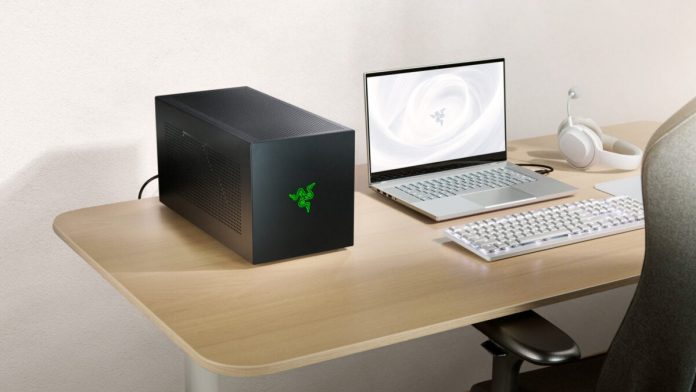I want a future where we don’t need a desktop PC to get the best gaming graphics. Maybe I’m a dreamer who needs to keep on dreaming, but I think that that pie-in-the-sky wonderland is closer to reality than you may think, and all PC component makers need to do is hop on the eGPU train. Better yet, they need to make something that’s as easily dockable as a Switch 2, but with the added power of a discrete graphics card that could push a laptop or gaming handheld into a full desktop experience.
The recently revealed Razer Core X V2 has been weighing on my mind as much as it seems it would weigh down my desk. At its core, it’s an eGPU, or external graphics processing unit. The GPU normally handles the most intensive rendering tasks necessary for high-end creative apps or gaming. Razer’s latest version is a $350 shoebox filled with surplus PC parts that could bump up the gaming potential of your average lightweight laptop. It makes use of Thunderbolt 5 connectivity to allow for faster data transfer speeds, though it will only grant those 80 Gbps bidirectional speeds with a compatible device that also has a Thunderbolt 5 port. It’s compatible with USB-C-based Thunderbolt 4 laptops and USB 4 handhelds, but those devices also need to support external graphics to get the juice from the discrete GPU.
We’ve seen similar designs from companies like Gigabyte with its recently announced Aorus RTX 5090 AI Box. It’s the opposite of what I want to see from an eGPU. Even after you spend the Benjamins on Razer’s case, you have to source your own graphics card and power supply with enough wattage to power it. This means you’re already halfway there to a mini ATX desktop.

It could be so much more. Why does it have to be in a box, anyway? Couldn’t an eGPU enclosure be a complete docking station for your laptop or handheld? Imagine how nice it would be, after schlepping around town all day, to take your lightweight laptop, slot it into your desktop battle station, and then be set up for a console-like gaming experience.
To keep it low-profile, you would need to engineer some novel ways to power the device and still manage excess heat. Smaller companies like Ayaneo sell the $600 Graphics Starship with an AMD Radeon 7600M XT housed inside. That eGPU has reverse power support for up to four monitors. It’s still pretty chunky, which is why the better options for some kind of dockable device lie in laptop GPUs. We could have slimmer boxes with a device-specific slot for a laptop or handheld. It could have enough ports to support multiple monitors and include USB and Ethernet. What I’m saying is: what if Razer combined its Dock Chroma with a laptop-level eGPU?

Asus kicked off 2025 with the promise of the XG Mobile eGPU with Thunderbolt 5 support and up to Nvidia GeForce RTX 5090-level graphics. Gizmodo first saw it in January this year, but it has yet to see the light of day. Asus promised it would be compatible with a $900 Asus ROG Ally X, but we don’t yet know how well this could improve the graphics capabilities of the company’s most expensive handheld. The upcoming ROG Xbox Ally X with the all-new Xbox-ified version of Windows has the same USB 4 connection, so it will similarly support the XG Mobile should it arrive sometime later this year. As for pricing, all we have right now are rumors, but I don’t expect either the Xbox Ally or XG Mobile to be cheap.
Desktops will still have the edge in graphics capability above any mobile dock, especially if they house a solid gaming CPU like AMD’s leading Ryzen 7 9800X3D. The data speeds will continue to be a hindrance. USB 4’s bandwidth maxes out at 40 Gbps, which may not be enough for the highest-end GPUs. Plus, so few handhelds have USB 4 compatibility. You can’t hook up a Steam Deck unless you do surgery on your device to enable Oculink—a separate type of fast data connection. We need to wait for the next era of handheld APUs—AKA accelerated processing units—to see if their performance matches up with an external graphics card and makes the setup worth the cost. I’ll just keep dreaming until some saint-like Santa figure finally hears my pleas.
